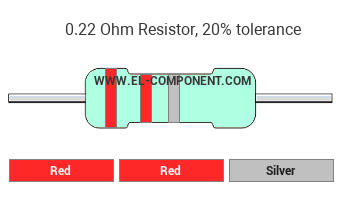0.22 Ohm Resistor Color Code
Resistor color code is a color code to indicate the resistance of that resistor. Resistor color code can be formed with 3, 4, or 5 color bands. Each band has their own number to form a resistance number. The body color doesn't have any meaning.
The figure below shows the color coding of the 0.22 Ohm resistor with a tolerance of ±20%. The color code of resistor with 3 bands will be with colors of the bands are Red, Red and Silver.

How To Read a Resistor Color Code for 3-band resistor
The color of the first band indicates the value of the first significant digit. The first band is Red, which corresponds to the value 2.
The color of the second band indicates the value of the second significant digit. This band is Red, which corresponds to the value 2. This is added to the right of the first digit (from band one). Therefore the digits from band one and band two are: 22.
The third color band represents a decimal multiplier by which the first two digits must be multiplied to obtain the resistance value of the resistor. Takes the digits and multiplies them by a value given by this band. The actual multiplier is 10n, where n is the value of the band color. In this case, the third band is Silver which corresponds to the number -2. Therefore the multiplier is 10-2 = 0.01.
So the total value of the resistance given by the colors is 22 x 10-2 Ω = 0.22 Ω.
As a result, the resistance value of the resistor with the color bands of Red Red Silver is 0.22 Ohm with ±20% tolerance.